Below are details of local birds, illustrated by tiles by Bronwyn Williams-Ellis, which decorate our campsite facilities. Many thanks to Rhodri Thomas for detail about these.

Grey heron
Grey heron [Crëyr glas](Ardea cinerea): This wading bird is often at the campsite, standing on the lake shore or flying overhead.They feed in shallow water, catching fish, frogs, and insects with its long bill. In folklore it was believed that the scent of a heron’s foot attracted fish so that they could then be caught, and fishing lines were sometimes rubbed with various preparations accordingly. In Shakespeare’s time hunting herons with peregrine falcons was a popular sport, and they appeared on the menu at banquets.

Barn owl
“The Llyn Gwynant Barns had everything we were looking for in a wedding venue: stunning scenery, a place for our guests to camp to really make a weekend of it, and a space that we could decorate exactly how we wished. Barn owl [Tylluan Wen](Tyto alba): These are one of the most widespread, though not common, of all birds worldwide, and you may see them flying at night across open fields, including over the campsite. They appear like a ghostly will-o’-th’-wisp as they fly past at night because of their white underparts and silent floating flight. Barn Owls declined considerably in Britain during the 1960s due particularly to the accumulation of rodent poisons in their bodies, but have since recovered.

Buzzard
Buzzard [Bwncath] (Buteo buteo): The soaring flight of a buzzard, with its wings tilted up in a distinctive shallow “v” and its mewing call, is very evocative. This large now common bird is most typically seen circling high above the valley, or sitting on fence posts watching for food. They feed on insects, lizards, worms, small mammals and carrion. Typically other birds, even swallows may gather together to mob buzzards and drive them off. Nests are bulky and messy in trees and contain 2 or 3 nestlings. Once common throughout Britain, persecution during the 19th century restricted them to the north and west. Since the 1960s however, legal protection and the cessation of organochlorine pesticide use has resulted in their spread back into former haunts, so that they are now Britain’s commonest and most widespread bird of prey.

Osprey
Osprey [Gwalch y pysgod](Pandion haliaetus): This large endangered “fish eagle” became extinct in Britain in 1916, but recolonised Scotland in 1954. It now has a local breeding site at Prenteg, near Tremadog where there is a viewing hide- one of just two current breeding sites in Wales. Ospreys feed on fish, sometimes heavier than themselves, and can spot a fish near the surface from from 70 metres up in the air. British birds migrate to West Africa for the winter.
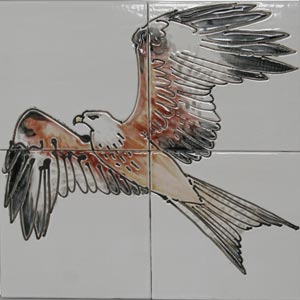
Red kite
Red kite [Barcud coch](Milvus milvus): 200 years ago kites were common over much of Britain, but by the 1930s persecution and habitat changes had restricted them to a last refuge in mid-Wales, where less than 20 birds survived. This small population clung on until the 1980s and then started to increase and spread thanks to conservation efforts, so that by 2000 there were about 260 pairs in Wales. The Red Kite has thus become a symbol of Welsh wildlife and, in 2007, was voted Wales’ favourite bird, although it has now also been introduced in England and Scotland. This bird of prey is primarily a scavenger feeding on carrion, but will also take mice and voles and shrews, and in Spring also earthworms. You see them circling locally with their distinctive forked tail. They are not migratory in this part of the world.
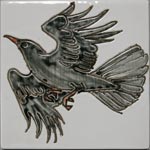
Chough
Chough [Brân goesgoch](Pyrrhocorax pyrrhocorax):This rare and charismatic red-billed bird is related to the crow. They pair for life and are not migratory. Found mainly on coastal cliffs and grassland, the handful of pairs breeding in Snowdonia are one of the few inland colonies. According to legend King Arthur turned into a chough on his death, and will rise again when the Chough returns to breed in Cornwall. They did so in 2001…watch this space!
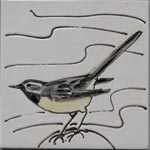
Grey wagtail
Grey wagtail [Siglen Llwyd](Motacilla cinerea): These handsome birds, unlike yellow wagtails with which they are sometimes confused, have the yellow restricted to the undersides and have a slatey-grey back. Breeding males have a black throat. They can be seen feeding on insects along fast-flowing stoney rivers and streams.
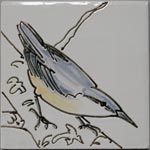
Nuthatch
Nuthatch [Delor y cnau](Sitta europaea): Characterised by large heads, short tails, and powerful bills and feet, nuthatches advertise their territory using a loud, rattling trill. They eat insects, nuts and seeds, jamming nuts into crevices and cracking them with blows of their beak. It is the only British bird that can climb down tree trunks (woodpeckers and treecreepers only climb up). The nest is built in a hole in a tree, and the entrance is reduced to exclude predators by the birds building a rim of mud around the margins of the hole until it is reduced to the right diameter.

Swallow
Swallow [Gwennol](Hirundo rustica): Swallows breed right across the northern hemisphere and we have many on the campsite including breeding pairs that think our toilet block is a great place to raise a family! Swallows are excellent flyers and feed on the wing, migrating to southern Africa for the winter- though as late as the 19th century swallows were widely thought to hibernate in the bottom of ponds. Pairs of mated swallows are monogamous and nest close to where they themselves were raised. In legend the swallow is reputed to have brought fire to man, burning its chest red in the process.

Raven
Raven [Cigfran](Corvus corax): These are the most common of the corvids locally, and are often on the campsite– in fact their population in north-west Wales has almost trebled since about 1950. Ravens live 10 – 15 years, occasionally up to 40, are omnivorous and intelligent. They live high up Snowdon and surrounding hills… and like our rubbish bins.
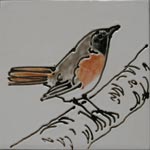
Redstart
Redstart [Tingoch](Phoenicurus phoenicurus): These insect-eating birds are summer visitors from Africa, and the upland oakwoods of western Britain are one of their favoured habitats. The males are colourful with a slate-grey back, red underparts, black bib and white forehead; the females are brown. Both male and female have a red tail, giving rise to its name (from Old English stert for tail).
